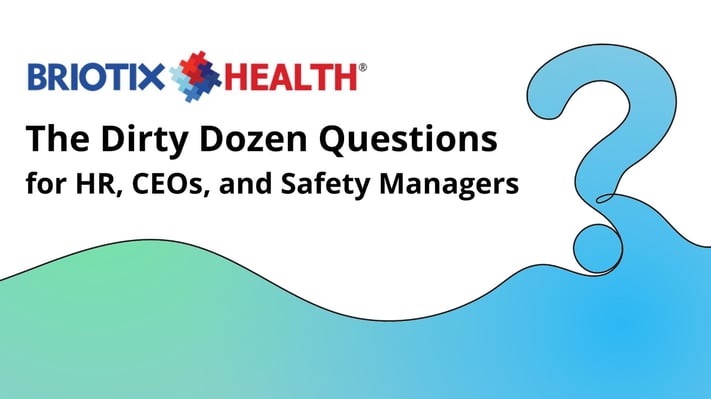
In an era where 'employee wellness' and 'ergonomics' have become as familiar as water-cooler talks about the latest Netflix series, we stand at a unique crossroads where employee wellness is no longer a peripheral luxury but a strategic necessity. During this shift, HR Managers, CEOs, and Safety Managers are instrumental in driving this evolution. Effective strategy building, especially in the complex terrain of injury prevention, starts with posing the right questions.
Jump ahead if you'd like 😉
4 Questions HR Managers Should Be Asking
4 Questions CEOs Should Be Asking
4 Questions Safety Managers Should Be Asking

HR Managers: The Shield Bearers
HR Managers, you hold the power to transform every office cubicle into a haven of productivity and safety. With Bureau of Labor Statistics (2021) reporting over 2.8 million nonfatal workplace injuries in 2022, it's clear that there's no room for complacency. Here are your four guideposts in this quest.
-
Are we promoting an ergonomic workspace? Ergonomics is not about buying fancy chairs with a million adjustments. It's about creating an environment that adapts to the worker, not the other way around. Incorporating ergonomic designs can reduce the risk of musculoskeletal disorders significantly, according to a 2023 study by CDC. A proper ergonomic environment requires a comprehensive approach, taking into account the individual's physical requirements, workstation setup, and task designs. Ergonomics helps in minimizing strain, preventing injuries, and boosting overall productivity.
-
Do we have proactive intervention measures? Early intervention programs like Briotix Health's Industrial Sports Medicine can identify potential risks and mitigate them before they morph into workplace injuries. Remember, prevention is better (and cheaper) than cure. Such strategies help identify and mitigate potential risks and foster a culture of safety and wellness within the organization.
-
Are we conducting periodic ergonomic assessments? Assessments provide a snapshot of your workplace's health. Regular evaluations can help spot potential hazards and keep the safety standards up to date. It’s like routine check-ups but for your office. Keeping up with these assessments ensures that the work environment is evolving in accordance with your employees' needs and changes in technology or processes.
-
Do we have a compassionate return-to-work program? Life after an injury can be challenging for employees. A well-structured return-to-work program can ease their transition back into the workforce and demonstrate that your company cares about their well-being. Such programs should be flexible, accommodating the unique recovery timelines and abilities of each employee, and show that your organization genuinely cares about its employees. Not only does this foster a positive company culture, but it can also enhance employee loyalty and engagement.


CEOs: The Treasurers of Health and Wealth
As the organization's helmsman, your perspective extends beyond quarterly earnings and annual reports. A study by OSHA in 2022 reported that businesses spent over $170 billion on costs associated with workplace injuries. Therefore, the link between employee safety and company profits is undeniable. Here are your four potent questions.
-
Are our employees trained in body mechanics?
As a CEO, it's crucial to acknowledge that body mechanics training goes beyond just preventing injuries—it's also about preserving the long-term health and productivity of your workforce. By investing in such training, you're not only helping to mitigate immediate risks but also proactively contributing to a healthier workforce. Moreover, training can be viewed favorably by insurers, potentially leading to reduced insurance premiums over time.
-
Does the company have an onsite injury prevention program incorporating Post Offer Employment Testing (POET)?
Onsite injury prevention programs that incorporate Post Offer Employment Testing (POET) go beyond being merely protective measures. They can act as significant assets to operational efficiency. POET is a proactive approach that validates your potential employee's ability to meet the physical demands of the job before their employment begins.
In cases where POET identifies potential employees who may need additional physical conditioning to perform their tasks effectively and safely, it creates an opportunity to devise customized conditioning programs. This preemptive action, paired with personalized attention from health providers when needed, can expedite recovery time and ensure safe integration into the workforce, ultimately boosting productivity.
-
Are we meeting OSHA's standards?
Compliance with OSHA's standards isn't just a legal obligation; it's a signal to your employees, partners, and investors that you prioritize safety. A company that maintains high safety standards is more likely to retain and attract talent, foster a culture of trust, and protect its financial and operational performance from the disruptive impact of workplace injuries.
-
How are we fostering employee well-being?
When considering employee well-being, recognize that it's a holistic concept, encompassing physical, emotional, and mental health. Comprehensive wellness programs can help reduce absenteeism, improve job satisfaction, and even enhance creativity and collaboration—essential elements for innovation and growth. Also, companies with a strong emphasis on employee well-being often have stronger employer brands, attracting top talent in competitive markets.


Safety Managers: The Guardians of the Work Galaxy
As Safety Managers, your role is the equivalent of a superhero minus the cape. Your duty is to ensure your workplace isn't a minefield of potential injuries. So, buckle up and ask yourself these critical questions.
-
Do we have a systematic injury recording process?
A systematic and thorough process of injury recording serves as a crucial data point for improving workplace safety. It aids in uncovering trends, exposing problem areas, and designing proactive interventions. Utilizing modern technologies for incident reporting can also streamline the process, leading to quicker response times and more effective preventative measures.
-
Is our employment testing in line with the job's physical demands?
Pre-employment testing designed to match the physical requirements of the job can be a game changer. It ensures that employees are well-suited for their roles, which not only aids in preventing workplace injuries but also increases productivity and job satisfaction. Tests should be fair, compliant with legal guidelines, and accurately reflect the demands of the job.
-
Have we implemented measures to prevent repetitive motion injuries?
Preventive strategies for repetitive motion injuries should be an integral part of any workplace health and safety program. Encouraging frequent micro-breaks, promoting a dynamic work environment, providing adjustable workstations, and educating employees about the importance of varying tasks and movements can significantly reduce the risk of these injuries.
-
Is our safety culture proactive?
A proactive safety culture is one where safety is not an afterthought but a primary consideration in all activities and decisions. It involves everyone from top-level management to entry-level employees, who all take responsibility for their own safety and the safety of others. This includes regular safety meetings, training, audits, feedback mechanisms, and ongoing improvements based on lessons learned. This fosters a culture of shared responsibility, where safety becomes a way of life rather than just a set of rules.


Striving for an Injury-Free Future
Equipped with these twelve insightful questions, HR Managers, CEOs, and Safety Managers are ready to champion workplace safety and wellness. However, posing these questions is just the starting point. True success lies in transforming the answers into tangible actions.
Envision a workplace where 'injury' becomes an alien term, replaced by the hum of productive keystrokes rather than moans of discomfort. Where ergonomic solutions, injury prevention, and employee wellness are not aspirational but an everyday reality.
Achieving this requires a proactive safety approach that cuts across departments and roles. Be it the HR manager spearheading ergonomic evolution, the CEO funding wellness programs, or the Safety Manager rolling out robust injury prevention initiatives, each person plays a critical part.
As we strive towards this ideal of workplace wellness, let's maintain our sense of humor. A light-hearted approach can turn even the most formidable challenges into manageable tasks. Here's to ushering in a safer future with a smile and a round of applause.
Here's to a future where sprains come from high-five celebrations, not from occupational hazards. Where workers’ compensation is an infrequent term in the company lexicon. And where employee well-being outshines every other measure of success.
As a wise safety sage once said, "An ounce of prevention saves a ton of workers' compensation." So, let's invest heavily in that prevention, shall we?
In the battle against workplace injuries, may the odds (and ergonomics) be ever in your favor. And remember, no victory was ever achieved without asking the right questions. After all, the journey to an injury-free workplace begins with a single question. Or in this case, a dozen.
